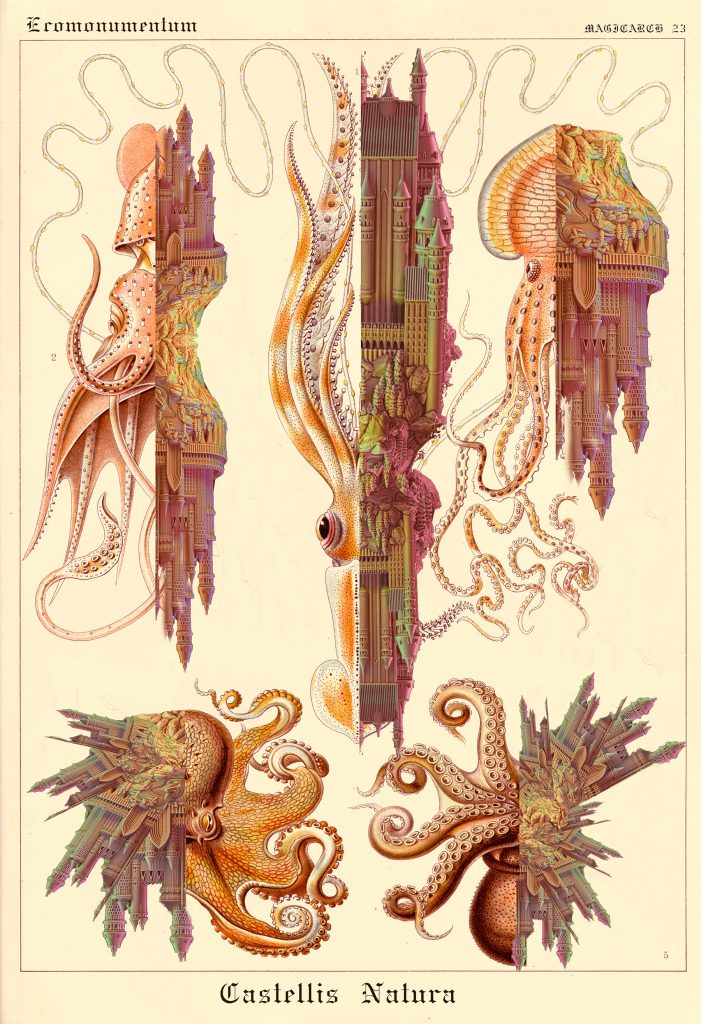Castle of Nature
ECOMONUMENTOLOGY 5.0
Castle of Nature
ECOMONUMENTOLOGY 5.0
“The scarcity of synthetic material resources on the planet has created a new market niche: Nature Factories. Nowadays is happening in the Castles of Spain. This new economy has found other places where large extensions of ecosystem fabric and organic life can be produced. Is there a little hope where we can live again as colleague species? Economist Janet Yellen already declared in the Times of 2032 «The Factories of Nature are an oasis towards where life can be created among the toxic putrefaction of the territories and where we can breathe clean air far from radioactive storms, a door the post-Anthropocene «.
The ‘Castillos de la Mancha’ in Spain are an unexpected market niche and they have become a focus of attention for investors of all origins. Angela Bassett was one of the pioneers in 2028 buying the Castillo de San Servando, in an interview she stated: «These medieval monuments are the new planter in which to cultivate the future and from where I will produce my new film work while raising dolphins«. Recently in 2036, the Spanish scientist Adriana Vergés started a campaign where she amplified the ecological-architectural research of several architects about the Castles: the medieval material ecology researched by Neri Oxman, the castle climatic efficiency researched by Izaskun Chinchilla at Garcimuñoz Castle and the Castle catalogued as Ecomonument by Magicarch. Therefore, Adriana Vergés connecting the discoveries that the architects made about the abandoned Castles, she repositioning them as extremely ecological actants. These Castles have high capacities for climatic production and reconnection towards biodiversity. «Its strategic position in the territory added to the mediterranean climate, means that manyof the Castles have a perfect climatic geolocation to optimize resources such as wind, humidity, temperature regulation… and above all, the important thing is that several species can coexist with the factories» Magicarch already published in 2027.
The diplomatic complexity of the matter joined to the sexy context of the Castles has attracted personalities from all over the world. Laurene Powell Jobs has already announced the purchase of two of the fortresses with techno-scientific intentions. This has alarmed another activist: «We need other economic policies of the Ecology Affairs, as a transforming mechanism that our daughters and sons can inherit» shouted Greta Thunberg, who has managed to paralyze the purchase of some castles since her famous MFF movement (Monday for future, strike of mothers and fathers who work on Mondays), as it testifies that these investors want to create a new empire of Nature Factories, should our ecological heritage be for sale? ”
Castles of Nature, Political Ecology, Factories of Nature, Ecomonuments, Banking Nature, Castle of Spain.
Castillo de Naturaleza
ECOMONUMENTOLOGÍA 5.0
“La escasez de recursos de materia sintética en el Planeta, ha creado un nuevo nicho de mercado: las Fábricas de Naturaleza. Esta vez está sucediendo en los Castillos de España. Esta economía, ha encontrado otros lugares donde producir grandes extensiones de tejidos ecosistémicos y vida orgánica, ¿una pequeña esperanza donde volver a convivir como especies compañeras? La economista Janet Yellen ya declaró en el Times de 2032 “Las Fábricas de Naturaleza son un oasis donde poder crear vida entre la putrefacción tóxica de los territorios y donde respirar aire limpio entre las tormentas radioactivas, una puerta hacia el post-Antropoceno”.
Los ‘Castillos de la Mancha’ en España son un inesperado nicho de mercado, y ya se han convertido en un foco de atención para inversoras de todas las procedencias. Angela Bassett fue una de las pioneras en 2028 comprando el Castillo de San Servando, en una entrevista afirmaba: “Estos monumentos medievales, son el nuevo macetero en el que cultivar el futuro y desde donde produciré mi nueva obra filmográfica mientras crío delfines”. Recientemente en 2036, la científica española Adriana Vergés inició una campaña donde amplificaba las investigaciones ecológico-arquitectónicas de varias arquitectas sobre los Castillos: la ecología de los materiales medievales de Neri Oxman, la eficiencia climática averiguada por Izaskun Chinchilla en el Castillo de Garcimuñoz y la catalogación de dichos castillos como Ecomonumentos en el listado de Magicarch. Así pues, Angela Vergés, conectando los descubrimientos que las arquitectas realizaron sobre los Castillos abandonados, los vuelve a mediatizar y los posiciona como actantes altamente ecológicos. Estos Castillos poseen altas capacidades de producción climática y de reconexión hacia la biodiversidad. “Su posición estratégica en el territorio sumado al clima mediterráneo, hace que muchos posean una geolocalización climática perfecta para optimizar recursos como el viento, la regulación térmica… y sobre todo lo importante es que varias especies podamos convivir con las fábricas” ya publicó Magicarch en 2027.
La complejidad diplomática del asunto ligada al seductor contexto de los Castillos, ha atraído a personalidades de todo el mundo. Laurene Powell Jobs ya ha anunciado la compra de dos de las fortalezas con intenciones tecnocientíficas. Esto ha alarmado a otra activistas: “Necesitamos otras políticas económica de lo ecologizante como mecanismo transformador que puedan heredar nuestras hijas e hijos” gritaba Greta Thunberg, quien ha conseguido paralizar la compra de algunos castillos desde su famoso movimiento MFF (Monday for future, huelga de padres y madres que trabajan los lunes), ya que atestigua que estas inversoras quieren crear un nuevo imperio de Fábricas de Naturaleza ¿debería estar nuestra herencia ecológica a la venta? ”
Castillos de Naturaleza, Ecología Política, Fábricas de Naturaleza, Ecomonumentos, Banking Nature, Castillos de España.
